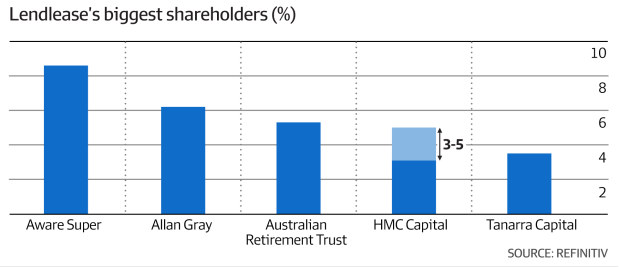Shareholders have watched its market cap slump to $4.3 billion from $11 billion in 2000 when the company embarked on global expansion. Lendlease chief executive Tony Lombardo, who is preparing for an investor strategy presentation next month, said the company had already cut costs and was simplifying its businesses.
Mr Mawhinney’s Allan Gray owns 6.2 per cent of Lendlease.
Mr Wylie is not the first Lendlease shareholder to call for radical change at Lendlease. In a 15-page presentation to the board in August, David Di Pilla’s HMC Capital called on the company to accelerate non-core asset sales.
On Thursday, Mr Di Pilla told the Financial Review that Lendlease’s performance was “disappointing” but believed the company was headed in the right direction.

“Lendlease’s performance has clearly been disappointing, and it is evident that more decisive strategic action needs to be taken,” he said. “We are confident the board and management team understands this and recognises the upcoming investor day will be a critical opportunity to clearly communicate a revised strategy to the market.”
Mr Lombardo has previously admitted more could be done to shore up shareholder returns. But he has previously noted that Lendlease had “simplified the organisational structure and slimmed management layers”, resulting in $320 million in reduced costs. Lendlease sold its master planned communities business to Stockland for $1.3 billion in December. In May, it sold a 21 per cent stake in its US military housing scheme.
“We believe the initiatives that Lendlease has already articulated are moving in the right direction – namely repatriation of capital back to Australia, scaling back offshore construction, reducing exposure to long-dated projects and ongoing progress on cost efficiencies,” Mr Di Pilla, HMC Capital’s chief executive, said.
Aware Super and the Australian Retirement Trust, which hold 8.6 and 5.3 per cent stakes in Lendlease respectively, declined to comment.
‘Holding their feet to the fire’
Mr Mawhinney said Lendlease’s capital costs needed “to fall dramatically” and wanted a commitment to “wholesale exits” from international developments.
“It is about holding their feet to the fire,” he said. “I do not think it is committed to wholesale exits from geographies. That is what people want. And we want them to report on the progress of it all frequently to shareholders”.
To better monitor underperforming projects, Mr Mawhinney suggested Lendlease create two companies, one with its Australian assets and a second with overseas efforts that it could exit.
“If the strategy is [to exit overseas] then I think they need to articulate that, and separate the business so that we can look at the two parts going forward,” he said.
“Then you can see the progress they are making on recycling that capital [that was intended for overseas projects]. They should pay debt initially, and then give what they do not need to keep, back to shareholders”.
Selling, or exiting, construction projects, however, has grown challenging as commercial property valuations have tanked since interest rates rose and offices were emptied after some staff members opted to work remotely. By early 2024, banks caught up in a property slump in the United States, for example, had set aside billions of dollars to cover loans.
Mr Mawhinney said Lendlease had a slew of assets that could find buyers, such as the Tun Razak Exchange – a shopping centre development in Malaysia.
“[It] is a really big asset. I would expect investments, or completed developments like that will have keen buyers,” he said. “[Lendlease] is not a company with a bunch of ‘C’ grade developments that no one wants. It is just a question of price.”